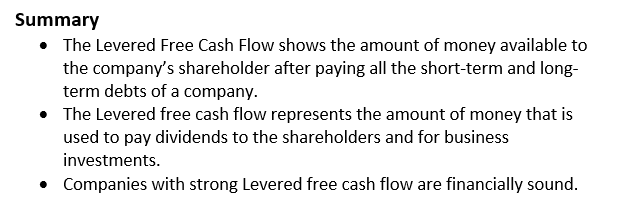What is Levered Free Cash Flow (LFCF)?
Levered free cash flow, or LFCF, refers to the remaining amount of cash that has been left to shareholders after paying all the obligations of a company. The Levered free cash flow shows the amount of money available to the company’s shareholder after paying all the short-term and long-term debts of a company.

Source: Copyright © 2021 Kalkine Media
Understanding Levered Free Cash Flow (LFCF)
The Levered free cash flow represents the amount of money that is used to pay dividends to the shareholders and for business investments. The Levered free cash flow is one of the best gauges to measure a company’s capability to grow. A company needs more cash at the time of expansion of business or introducing a new product in the market. Small scale companies are generally able to finance their operations without raising debt capital. Whereas large scale companies need to arrange more capital by different option of finance such as debt financing (bank, issuing debentures etc.), equity finances (investors capital).
Companies with strong Levered free cash flow are financially sound because strong Levered free cash flow shows a company’s ability to meet their obligations, distribution of dividend and grow.
On the other side, weak levered free cash flow represents that a company is not able to meet its financial obligations because of insufficient cash. In order to calculate levered free cash flow, an individual should know the capital expenditures, cash flow from operation, income interest and expenses interest of a company.
Frequently Asked Questions (FAQs)
How to calculate Levered Free Cash Flow (LFCF)?
The Levered Free Cash Flow (LFCF) can be calculated by using the given formula, which is:
Levered free cash flow (LFCF) = EBITDA – Δ net working capital - CAPEX - mandatory debt payments
Where, EBITDA stands Earnings before interest, taxes, depreciation, and amortization refers to the normal earnings or the total income (net) of a company that is used by investors to estimate and analyze the overall financial performance of a company.
CAPEX stands capital expenditures; it includes investments in different assets such as machines, property, equipment, buildings inventory including accounts receivable, accounts payable.
Δ Working capital refers to the change in the net working capital of a company. Working capital refers to total capital required for the operations of a company
Mandatory debt payments refer to the amount that a company owes to debtors including interest, lenders, investors, etc.
What Levered Free Cash Flow means
The Levered free cash flow defines as measure of a firm's ability to increase its business and capability to distribute returns to its shareholders from its generated money through operations over a period. The Levered free cash flow can be used by investors and lenders as an indicator of a firm’s ability to get more capital by financing. A firm with strong levered free cash flow attracts more investors and becomes a low-risk borrower and if a firm has more debt and has insufficient cash to meet its obligations, it may be hard for a firm to get more financing from a lender such as banks, credit unions, and other financial institutions.
If a firm’s levered free cash flow is weak and negative, it may because of insufficient cash to meet the obligations. A negative levered free cash flow does not surely specify that the firm is failing as sometimes firms may do substantial capital investments that have yet to begin paying off. Investors are also keen to know what a company prefers to do with its levered free cash flow. Sometimes, a firm prefers to make investment of its levered free cash flow or may devote an amount of its levered free cash flow to distribute dividend to shareholders.
Difference between Levered Free Cash Flow and Unlevered Free Cash Flow
The Levered free cash flow refers to an amount of money a firm has after meeting all its obligations including debts. The Levered free cash flow is amount cash available to make payments of debtholders and distributing dividend to shareholders. The Levered free cash flow indicates the profitability of a firm. On the other hand, unlevered free cash flow refers to an amount of money a firm has before making its debt payments and meeting its financial obligation. Unlevered free cash flow (UFCF) defines as the gross free cash flow produced by a firm over a period.
The difference of Levered free cash flow and unlevered free cash flow consider a major indicator of a firm’s profitability, the amount of financial obligations a firm has, and health of a firm based on a firm’s debt. If a firm has more expenses that its earnings, the levered cash flow would be negative, which shows an unideal situation of a firm. Unlevered free cash flow refers to the available amount of cash to a company to make the payments of all stakeholders in a firm, including debt holders and shareholders (equity holders).
 Please wait processing your request...
Please wait processing your request...